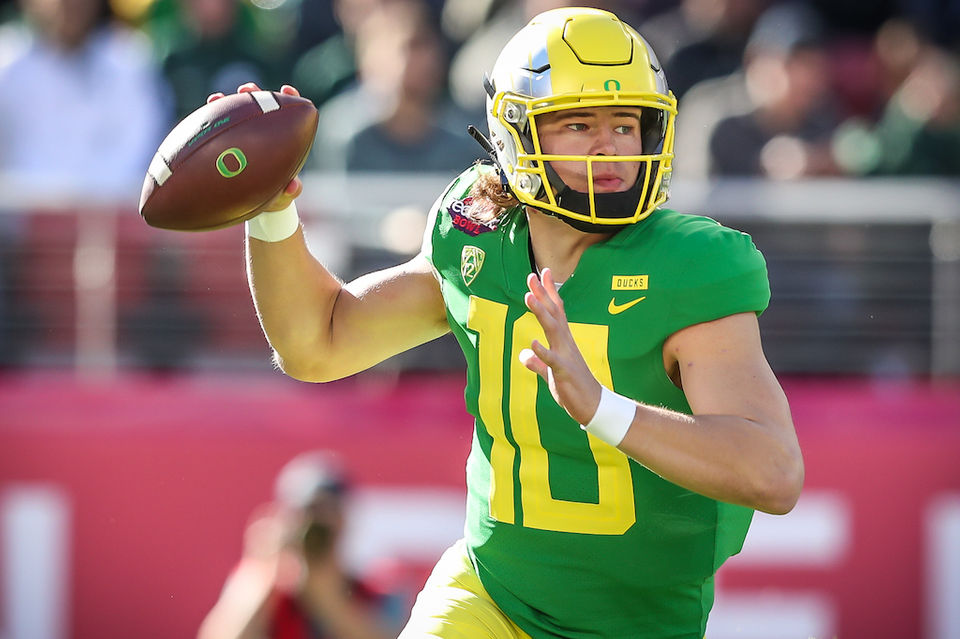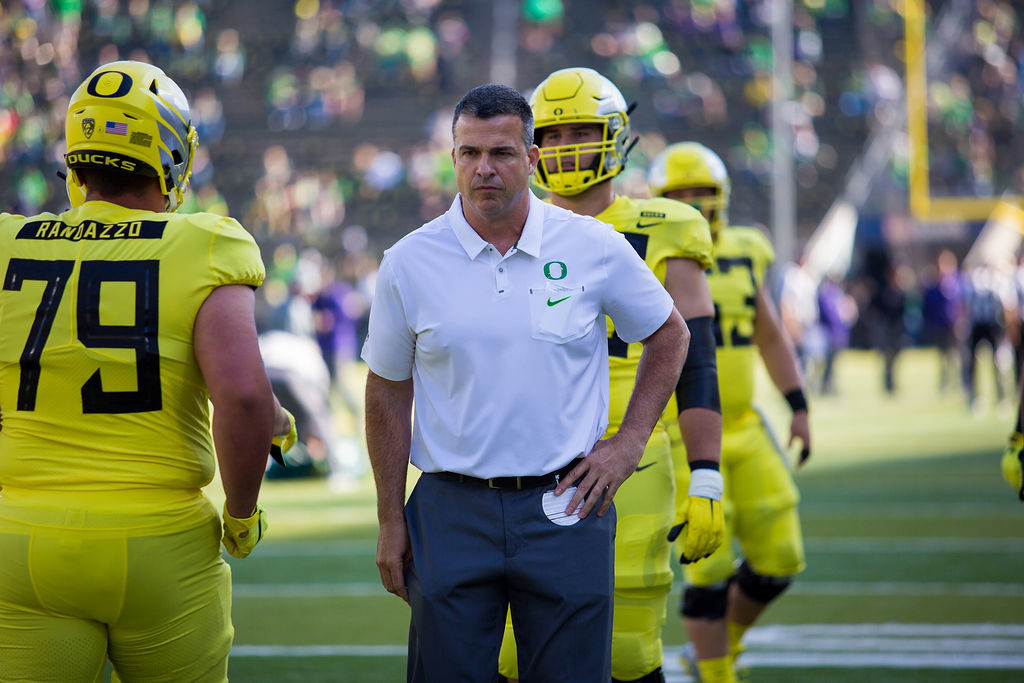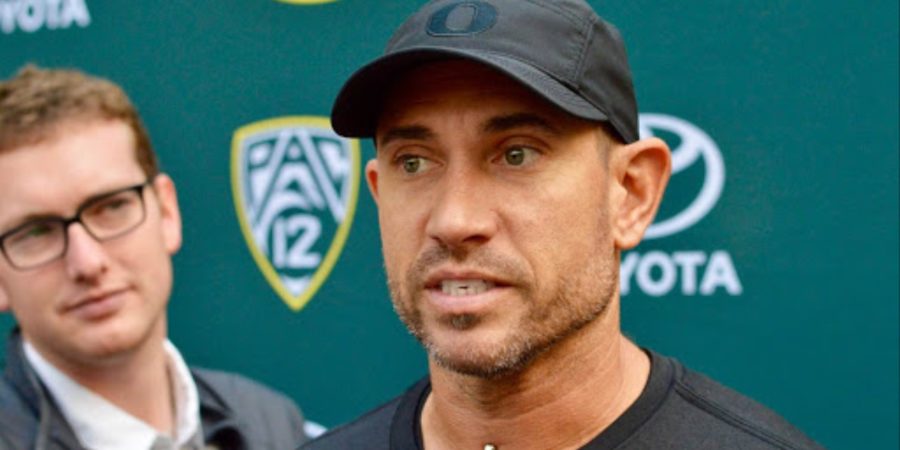By virtually all accounts, the 2018 campaign – Oregon’s first under head coach Mario Cristobal – counts as a success.
The Ducks not only finished the year with their first nine-win season and first victory over rival Washington since 2015, but they also secured their first bowl victory and first win over a top 10 team since 2014.
For a program that enjoyed seven consecutive seasons of 10 wins or more from 2008-’14, which included five bowl victories, six AP top 10 finishes, four conference titles, and two appearances in the national championship game, there’s no doubt 2018 was a step in the right direction.
However, any person who has followed the program closely over the past two decades would readily admit that, as encouraging as the 2018 season was, it ultimately ended with a sense of wanting more, particularly considering the way the Ducks finished the last half of the season on offense.
After jumping out to a 5-1 start, the Ducks would go 4-3 to finish out the season, which was underscored by a dismal 1-3 record on the road (the lone road victory coming against a floundering Oregon State team). The primary culprit? An offense that simply lacked consistency across the board from one week to the next.
The proof is in black and white.
Over the first six games of the season, the Oregon offense averaged 482.8 yards of total offense (209.5 ypg rushing, 273.3 ypg passing) and 43 points per game. Over the final seven games, the Ducks averaged just 379.6 yards of total offense (153.6 ypg rushing, 226 ypg passing) and only 27.9 points per contest – a staggering departure from the offensive wattage seen through the first half of the year.

In fact, despite possessing one of the most experienced offensive lines in the conference, the Ducks were held to less than 100 yards rushing as a team in three of those final seven games. For perspective, Oregon rushed for less than 100 yards as a team on only three separate occasions in the previous six seasons; a disturbing reality especially when coupled with Cristobal’s celebrated background as an offensive line coach.
Of course, some will attribute the rushing downturn to the absence of Penei Sewell, as the all-world true freshman left tackle was playing at an all-conference caliber level before an ankle injury suffered in the win over Washington sidelined him for the final six games of the regular season. Yet, while Sewell’s void was certainly notable, it’s also reasonable to believe that the impact of his loss should have been more or less neutralized if we’re to invest in the perceived depth and talent of Oregon’s offensive line.
It wasn’t, which quietly raises doubts surrounding the potency of an Oregon ground game that was lacking its standard pop even before Sewell’s injury last season.
More concerning than that, however, were the frustrating and well-documented issues in the passing game. Drops, a dearth of experience, and a lack of outright difference makers accurately summarizes a wide receiver unit that, despite Dillon Mitchell’s record-setting season, was undoubtedly the most compromised position group on the entire roster in 2018. Though, as convenient a punching bag as Oregon’s wide receivers were a season ago, Justin Herbert also displayed tunnel vision all too often, while the situational play-calling on behalf of Cristobal and offensive coordinator Marcus Arroyo could be described as hard-headed and uninspired on multiple occasions within multiple games.
All of these factors combined to contribute to Oregon’s shortcomings on offense a year ago, but last season’s excuses, whether justified or not, can’t be tolerated in 2019. Not with Herbert entering his fourth season as QB1, not with the most experienced offensive line in college football on hand, and not with 10 of 11 offensive starters set to return.

So what kind of offensive standard should the Oregon fan base reasonably expect entering the second season of the Cristobal era?
For one, it’s fair to expect that Herbert elevate his game – and the game of those around him – to a level befitting of a player who many anticipate will be the first quarterback taken in next April’s NFL Draft. For parts of the last three seasons, Herbert has somewhat quietly operated as the leader of the Oregon offense. But if Oregon is to reach the lofty expectations expected of them, there can be nothing quiet about Herbert’s play in 2019. He must turn in his most complete and transformative season yet.
Secondly, the offensive philosophy employed by Cristobal and Arroyo last season has to have evolved into something much more efficient this season. At best, Oregon’s transition to the Pistol offense last season delivered mixed results, prompting Arroyo to state this offseason that there would be “new wrinkles” to Oregon’s offense in Year 2. What that actually means is anyone’s guess, but the philosophical deficiencies that plagued the Ducks a season ago can’t be the same issues that plague them this season.
Third, Oregon’s wide receivers must turn a corner and prove themselves to be reliable targets for Herbert in the passing game. The 52 reported drops that were attributed to Duck pass catchers last season is simply unacceptable, and that number should be roughly cleaved in half if the offense is to find real traction in 2019. The good news is that this unit is a year older and will receive a much needed influx of talent, beginning most notably with Penn State grad transfer Juwan Johnson and incoming freshman Mycah Pittman.
Lastly, the Oregon ground game needs to return to a form that better reflects their production over the first half of last season opposed to the second half. Yes, injuries impacted the Ducks’ depth in the offensive trenches last year, and yes, the Ducks relied heavily upon two freshmen running backs to carry the rushing load. And for the most part, both units held up admirably and lived up to expectations. But there’s a whole new set of expectations for those respective groups this fall. CJ Verdell and Travis Dye need to crystalize themselves as the Pac-12’s best rushing duo behind an offensive line that needs to definitively prove that it is one of the best position groups in the country.

